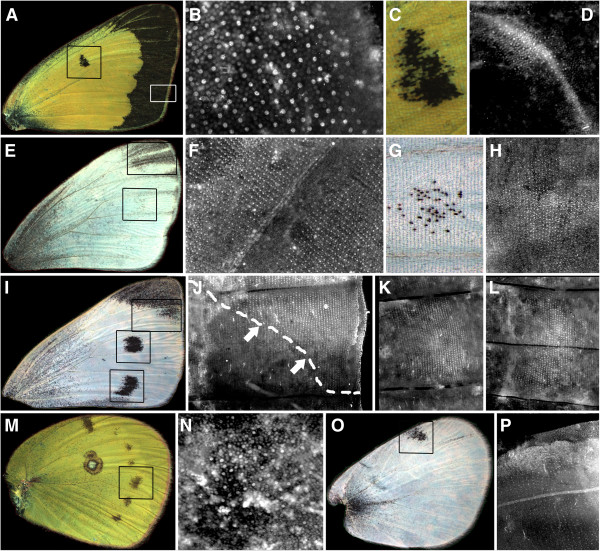Figure 2.
Melanic pattern elements in pierid butterflies that correlate with Sal expression. Wing surfaces depicted are dorsal forewings from (A) a male Colias spp.; (E) P. oleracea, sex unknown; (I) P. rapae female; (M) hindwing ventral surface of a male Colias spp.; and (O) dorsal hindwing of P. rapae. Insets indicate regions that are depicted at higher magnification to the right, in other panels. (B) Sal is expressed in scale-building cells (cells that show strong punctate expression and are arranged in regular rows) in the marginal region. The region where the cross-vein spot occurs in adults (C) also shows pupal expression of Sal in scale-building cell rows as well as in non-scale building cells (D) (24 h post-pupation; 25°C). (F) Sal is expressed in rows of scale-building cell at the wing tips of P. oleracea and in the (G, H) M3 wing spots (44 to 49.5 h post-pupation; 19°C). (J) Sal is expressed in rows of scale-building cells at the posterior margin of the wing-tip patch (arrows and dashed-line roughly indicate the border between Sal expression and lack of Sal expression, corresponding to the black-white transition of the adult wings), M3 spot (K) and Cu2 spot (L) (26.6 h post-pupation; 25°C). (N) Sal is expressed in rows of scale-building cells in the location where one of the spots will later develop (14 h post-pupation; 25°C). (P) Sal is expressed in rows of scale-building cells in the location where the spot (shown in O) will develop (23 h post-pupation; 25°C). Bright, non-regular spots on the wings correspond to non-specific staining or debris.

